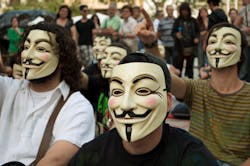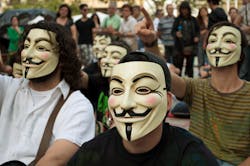As was reported following the storming of the U.S. Capitol in Washington, D.C. on January 6 by supporters of former President Trump, the FBI warned that further demonstrations, violence, or targeted attacks against government buildings or officials were possible in all 50 state capitals and Washington, D.C. in the days preceding President-elect Biden’s inauguration. Although there were no major incidents, federal, state, and local law enforcement stepped up security preparations in response to the threat of violent unrest, prompting many businesses, in potentially impacted areas, to review their own security postures.
The security plans enacted by our governmental agencies during this period were multi-faceted and integrated among many different agencies. They were, by design, overwhelming in their application and execution, ensuring that any individual or group planning an event, protest or riot, was aware of the security presence with their intention that what happened at the U.S. Capitol would not be repeated. The plans implemented across the U.S. were commensurate with past actions (note the U.S. Capitol riot) and threat intelligence developed (note the FBI advisory). It should be noted that a visible security presence is a deterrent.Building Your Security Framework
Typically, an organization’s security department will define the framework to protect its physical spaces, sites and employees. Driven by established priorities and an intelligence program, a firm will develop a Global Security Program and develop security game plans to ensure specific goals and objectives are accomplished. The specific plans are tailored according to direct and indirect threat vectors that apply to the areas that the firm wants to protect, that is, its employees, executives, sites and data. The threat information collected helps form the development of security game plans to accomplish the aforementioned mission are specific to its industry, the firm itself, its employees/executives, sites, or data.
As documented, civil unrest has been one of the threat vectors which firms and their global security, risk, human resources and legal departments have had to manage over the course of the past weeks and months — and will continue to demand vigilance for the foreseeable future. From incidents viewed recently as well in the recent past, the results of civil unrest have certainly stressed businesses’ security infrastructure, from their workspace and environs to the protection of their employees and business locations.
What to Do
While understanding that Global Security Program strategies and the tactical security game plans prepared in response were and will continue to be unique to every organization due to factors such as different threat landscapes, locations, size, culture, etc., key strategies, actions, and objectives are noted herein to assist firms and their employees during times of civil unrest, when protestors actually do show up at an organization’s site. Provided below are best practices for consideration should protesters show up at your facility:
● Contact local police departments and brief them on the protest activities for operational awareness purposes.
● Ensure the organization is aware of the local ordinances, laws, requirements, etc., related to protest activities, i.e., what can and can’t be done by the protestors, and whether a permit or other notification to local government authority is required.
● The local police department may engage with the protestors to convey local ordinance restrictions on the protest activity.
● Ensure ingress/egress from company grounds/property, etc., on the part of employees, visitors, or vendors, etc., is undeterred from the protest activity.
● The organization’s security team should ensure protest activity is monitored for any activity which does not comply with local ordinances, laws, etc., and report any incidents or threats incurred.
● Ensure appropriate security and safety measures, as well as proper notifications, are utilized to protect employees, visitors, or vendors who may be on company grounds
● Do not engage with or otherwise confront the protestors.
● The organization may consider enhancing security staffing and coverage during the period of protest which may include proprietary, contract guard service, or off-duty armed uniformed police officers.
● Ensure the firm’s onsite security are retrained on the firm’s policies and procedures relative to protest activity, and that appropriate protocols are adhered to and followed.
● Ensure internal briefing protocols and communication procedures are confirmed within the firm should any incidents or threats be reported.
Aligned with the firm’s duty to care for its employees, the following list of best practices aims to assist the firm and its employees in actions that may make them safer should employees find themselves in an incident of civil unrest. All actions below should be considered, if safe to do so.
● Avoid protest areas or large gatherings, if possible.
● Stay calm and maintain a low profile. Avoid discussions of the issues at hand; do not engage with the protestors.
● Be vigilant and increase awareness of surroundings. It’s easy. Simply pay attention to your surroundings, make observations, and draw appropriate conclusions. Learn to key in on the unusual or on someone/something that seems out of place.
● Trust your instincts; if something seems odd, or someone looks threatening, leave the area as quickly as possible.
● Actions that enhance your personal safety and security should be your sole focus.
● Remove all articles from your person which display wealth, including rings, watches, jewelry, etc.
● Identify the location of emergency exits and paths of egress from the area which has posed the most risk to your safety.
● Remember the five-step process for an active shooter type situation: awareness, assess the situation, consider your options (run, hide, fight) and risks, and then take an action.
● Quickly and safely remove yourself from the area where an incident may/is/has occurred.
● If you cannot safely remove yourself, seek shelter.
● Once your safety is secured, contact authorities and comply with the commands of authorities.
● Do not in any way appear or engage in a threatening manner to authorities.
● Avoid the targeted areas of the civil unrest, protest or riot, such as government buildings, police stations (unless seeking assistance), public places, restaurants, etc.
● Anticipate cell phone/landline disruption.
● Monitor local media, and/or other sources of information for updates.
● Follow your company’s communications plan and/or evacuation process.
● Consider establishing a communication plan for family members; review these actions with family members.
Related Resources:
Best Practices: Protecting Business Against Active Shooters and ‘Soft Target’ Attacks
Organizational Safety and Mental Health: Before and After an Active-Shooter Situation
About the author: Brian W. Lynch is the Executive Director of Safety and Security for RANE. Lynchbrings nearly four decades of senior management and executive-level experience in the fields of law enforcement, safety, and security. Prior to his retirement from Vanguard, Lynch served as the firm’s Head of Global Security wherein he designed and executed the firm's enterprise-wide Eight Phase Global Security Program, its 24x7 global operational model responsible for the identification, analysis, response, and resolution of security incidents, and its Active Shooter, Crisis Management, and Executive Protection Programs.During his tenure in the FBI, Lynch led the Bureau’s efforts in national security investigations by overseeing counterintelligence investigations and intelligence efforts by foreign intelligence services, tracking and seizing terrorist funds, as well as leading terrorism investigations through the FBI’s Joint Terrorism Task Forces, leading to the disruption of terror attacks. Lynch also led law enforcement and intelligence efforts at the FBI’s Terrorist Screening Center as Deputy Director of Operations. Lynch successfully conducted criminal investigations into white-collar crime, civil rights, violent crime, drug/gang matters and was a member of the FBI’s SWAT Team.
About the Author

Brian W. Lynch
Executive Director for Safety & Security at RANE
Brian W. Lynch is the Executive Director for Safety & Security at RANE. Lynch brings nearly four decades of senior management and executive level experience in the fields of law enforcement, safety, and security. Previously, Lynch served as Head of Global Security at Vanguard. He designed and executed the firm’s enterprise-wide Eight Phase Global Security Program which included the design and execution of the firm’s secure mail operations processes and training, as well as a 24x7 global operational model responsible for the identification, analysis, response, and resolution of security incidents. Lynch was also a Special Agent with the FBI, serving in investigative and senior executive level positions, over a 22+ year career.


